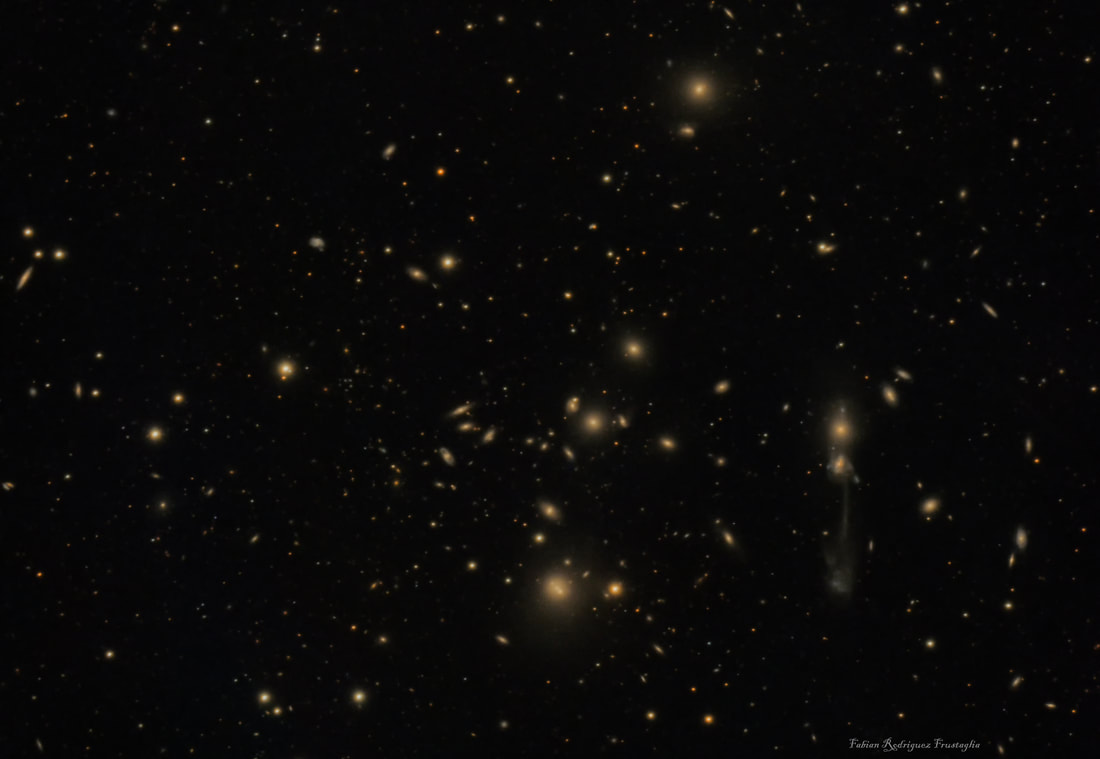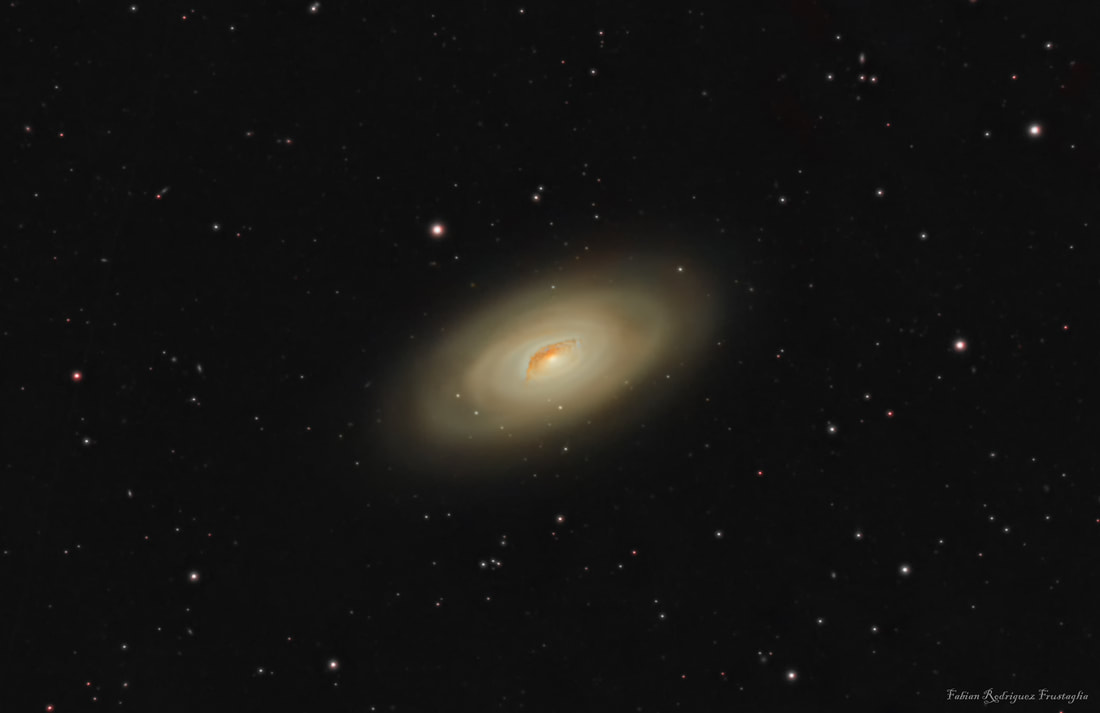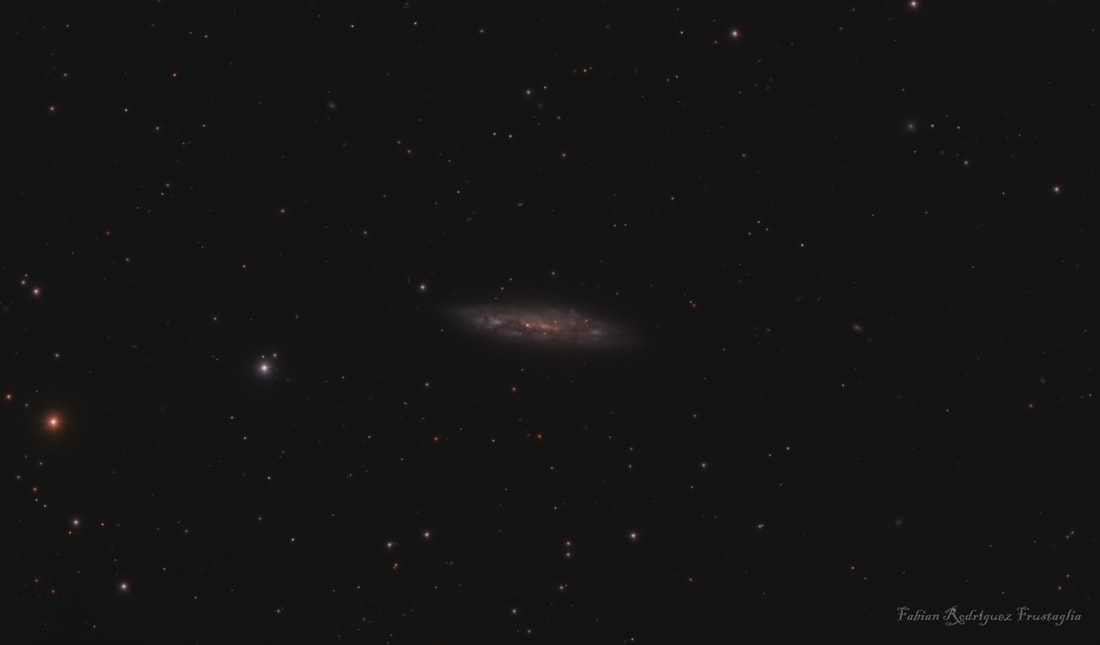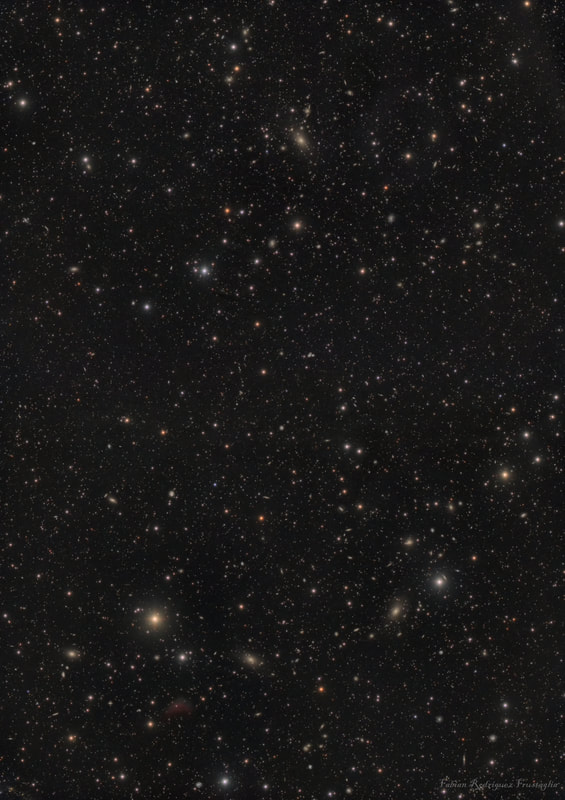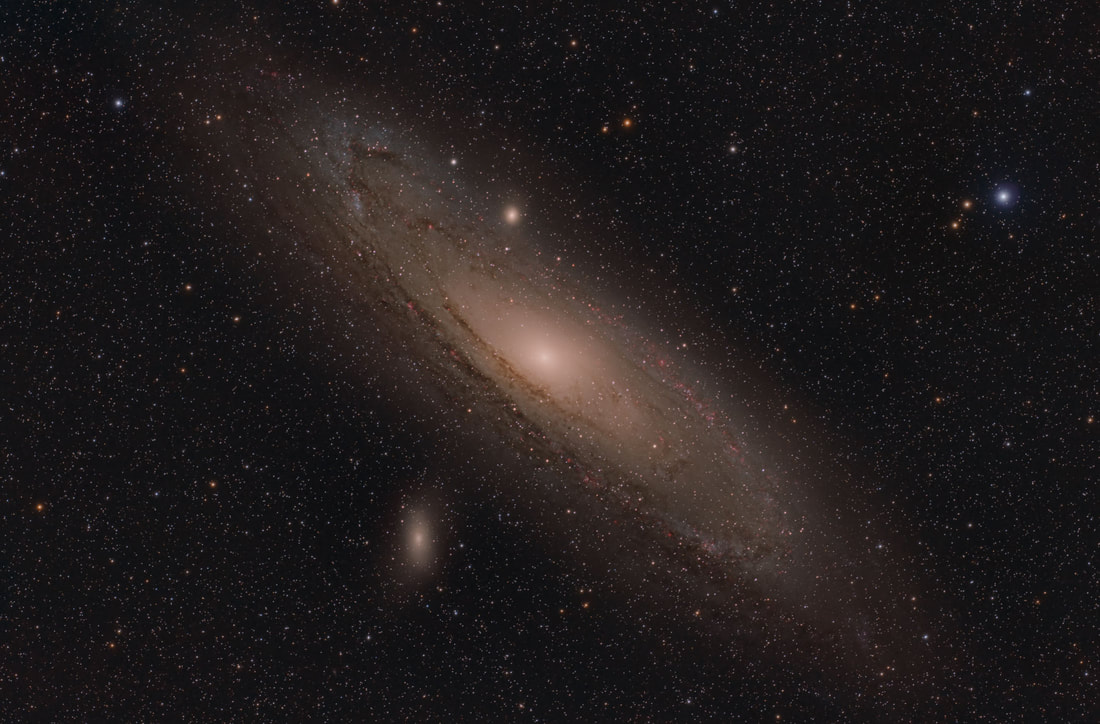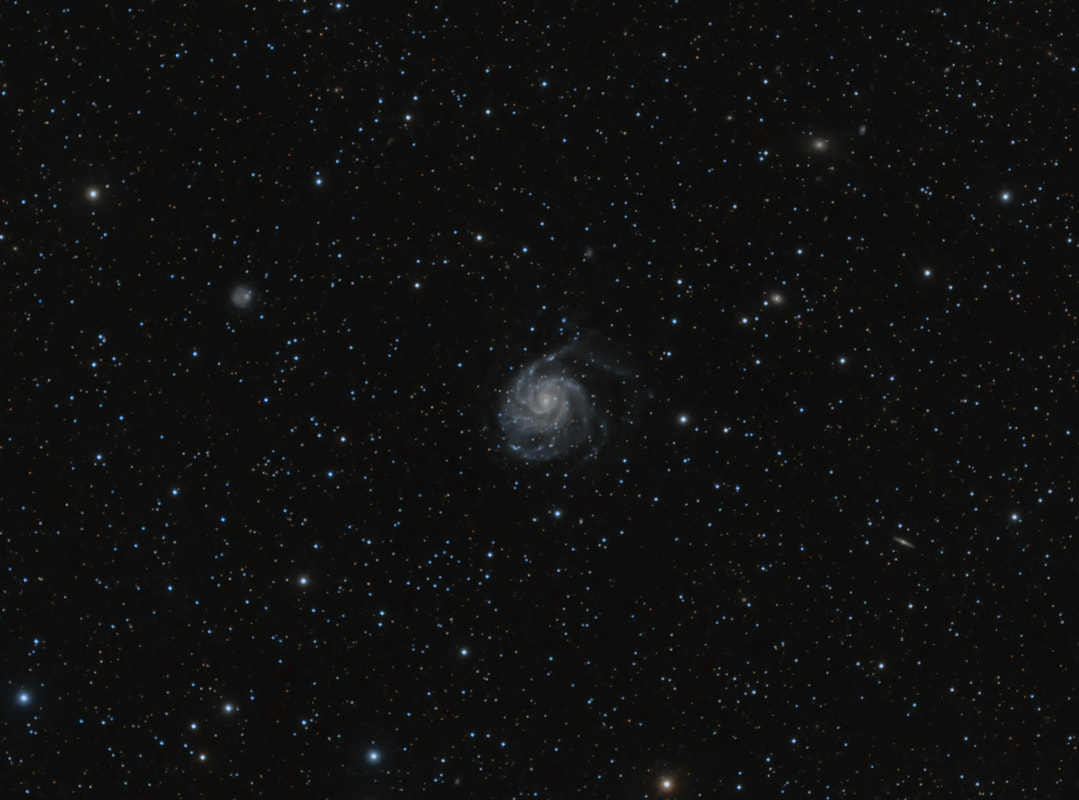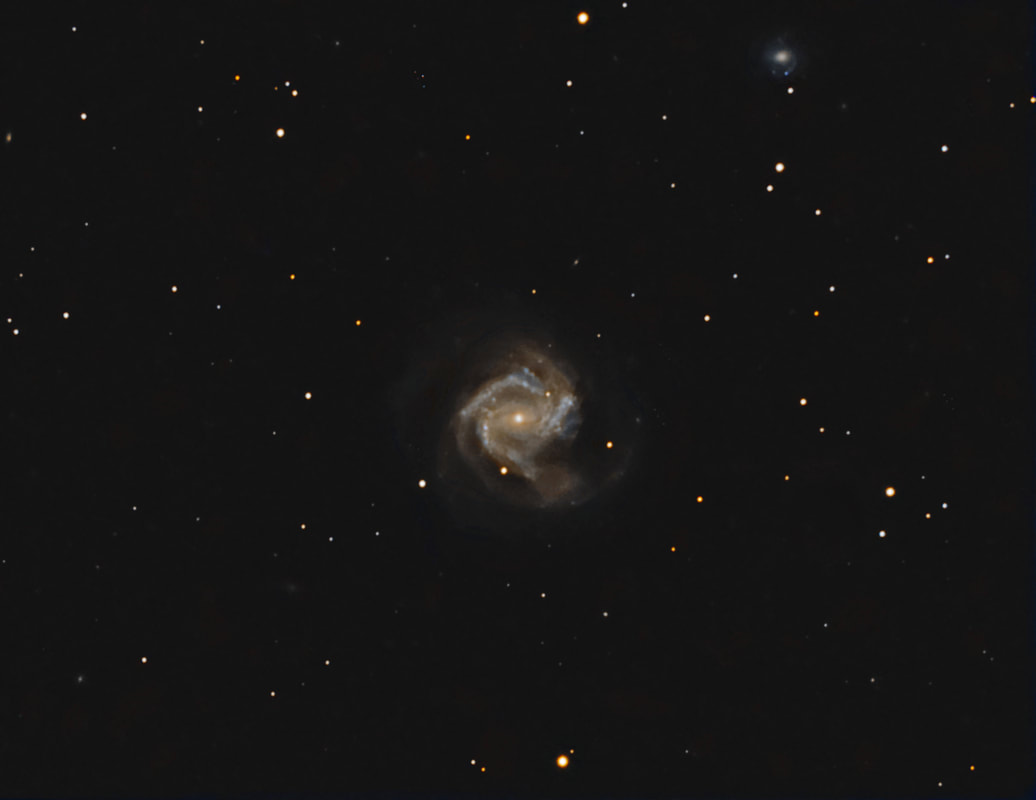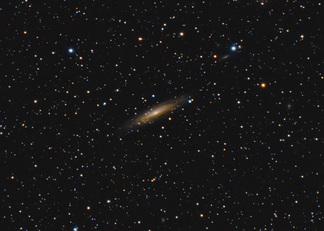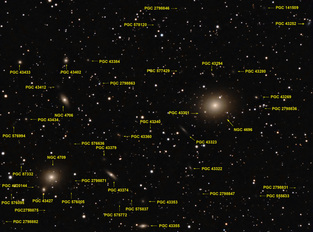Galaxies
CLICK ON AN IMAGE TO
VIEW IT AT FULL RESOLUTION
|
Messier 31 - Andromeda Galaxy
The Andromeda Galaxy , also known as Messier 31, M31, or NGC 224 and originally the Andromeda Nebula (see below), is a barred spiral galaxy with diameter of about 220,000 ly approximately 2.5 million light-years from Earth and the nearest large galaxy to the Milky Way. The galaxy's name stems from the area of Earth's sky in which it appears, the constellation of Andromeda, which itself is named after the Ethiopian (or Phoenician) princess who was the wife of Perseus in Greek mythology. The virial mass of the Andromeda Galaxy is of the same order of magnitude as that of the Milky Way, at 1 trillion solar masses . The mass of either galaxy is difficult to estimate with any accuracy, but it was long thought that the Andromeda Galaxy is more massive than the Milky Way by a margin of some 25% to 50%. This has been called into question by a 2018 study that cited a lower estimate on the mass of the Andromeda Galaxy, combined with preliminary reports on a 2019 study estimating a higher mass of the Milky Way. The Andromeda Galaxy has a diameter of about 220,000 ly, making it the largest member of the Local Group in terms of extension. This is a 6-panel mosaic through the refractor + a wide field view from the 135mm telephoto lens. Site: Entre Encinas y Estrellas, Spain Telescope: Meade Series 6000 APO 115 f/5.6 Camera: ZWO ASI2600 + SBIG 8300C Filters: ZWO LRGB + Ha Date: November 2021 Exposure: 93x300" + 20x600" /panel = 66.50 hrs |
|
Messier 51 - Whirlpool Galaxy
The Whirlpool Galaxy, also known as Messier 51a, M51a, and NGC 5194, is an interacting grand-design spiral galaxy with a Seyfert 2 active galactic nucleus. It lies in the constellation Canes Venatici, and was the first galaxy to be classified as a spiral galaxy. Its distance is 31 million light-years away from Earth. The galaxy and its companion, NGC 5195, are easily observed by amateur astronomers, and the two galaxies may be seen with binoculars. The Whirlpool Galaxy has been extensively observed by professional astronomers, who study it to understand galaxy structure (particularly structure associated with the spiral arms) and galaxy interactions. Site: Entre Encinas y Estrellas, Spain Telescope: Meade LX850 12" f/5.6 Camera: QHY268m Filters: LRGB + Ha Date: January 2022 Exposure: 110x300" + 13x600" = 11.33 hrs |
|
SDSS J1038+4849 - "Smiley Face"
In the center of this image is the galaxy cluster SDSS J1038+4849 — and it seems to be smiling. You can make out its two orange eyes and white button nose. In the case of this “happy face”, the two eyes are very bright galaxies and the misleading smile lines are actually arcs caused by an effect known as strong gravitational lensing. Galaxy clusters are the most massive structures in the Universe and exert such a powerful gravitational pull that they warp the spacetime around them and act as cosmic lenses which can magnify, distort and bend the light behind them. This phenomenon, crucial to many of Hubble’s discoveries, can be explained by Einstein’s theory of general relativity. In this special case of gravitational lensing, a ring — known as an Einstein Ring — is produced from this bending of light, a consequence of the exact and symmetrical alignment of the source, lens and observer and resulting in the ring-like structure we see here. Site: Entre Encinas y Estrellas, Spain Telescope: Meade LX 12" f/8.0 Camera: QHY268m Filters: Chroma LRGB Date: June 2022 Exposure: 582x300" = 48.50hs |
|
Messier 74 - Phantom Galaxy
Messier 74 (also known as NGC 628 and Phantom Galaxy) is a large spiral galaxy in the equatorial constellation Pisces.[a] It is about 32 million light-years away from Earth. The galaxy contains two clearly defined spiral arms and is therefore used as an archetypal example of a grand design spiral galaxy. The galaxy's low surface brightness makes it the most difficult Messier object for amateur astronomers to observe. Its relatively large angular (that is, apparent) size and the galaxy's face-on orientation make it an ideal object for professional astronomers who want to study spiral arm structure and spiral density waves. It is estimated that M74 hosts about 100 billion stars. Site: Entre Encinas y Estrellas, Spain Telescope: Meade LX 12" f/8.0 Camera: QHY268m Filters: Chroma LRGB + Ha Date: January 2023 Exposure: 144x300" + 18x600" = 15.0hs |
|
Arp 188 - Tadpole Galaxy
The Tadpole Galaxy, also known as UGC 10214 and Arp 188,[3] is a disrupted barred spiral galaxy located 420 million light-years from Earth in the northern constellation Draco. Its most dramatic feature is a trail of stars about 280,000 light-years long. Its size has been attributed to a merger with a smaller galaxy that is believed to have occurred about 100 million years ago. The galaxy is filled with bright blue star clusters triggered by the merger, some containing as many as one million stars. It is the largest disrupted spiral galaxy of its sort. Site: Entre Encinas y Estrellas, Spain Telescope: Meade LX 12" f/8.0 Camera: QHY268m Filters: Chroma LRGB Date: February 2023 Exposure: 104x300" = 8.66hs |
|
Messier 88
Messier 88 (also known as M88 or NGC 4501) is a spiral galaxy about 50 to 60 million light-years away from Earth in the constellation Coma Berenices. It was discovered by Charles Messier in 1781. Site: Entre Encinas y Estrellas, Spain Telescope: Meade LX 12" f/8.0 Camera: QHY268m Filters: Chroma LRGB + Ha Date: February 2023 Exposure: 105x300" + 14x600" = 11.08hs |
|
NGC 3344
Messier 88 (also known as M88 or NGC 4501) is a spiral galaxy about 50 to 60 million light-years away from Earth in the constellation Coma Berenices. It was discovered by Charles Messier in 1781. Site: Entre Encinas y Estrellas, Spain Telescope: Meade LX 12" f/8.0 Camera: QHY268m Filters: Chroma LRGB Date: December 2022 Exposure: 124x300" = 10.25hs |
|
Hickson 44
Hickson 44 (HCG 44) is a group of galaxies in the constellation Leo. As Arp 316, a part of this group is also designated as group of galaxies in the Atlas of Peculiar Galaxies. Site: Entre Encinas y Estrellas, Spain Telescope: Meade LX 12" f/8.0 Camera: QHY268m Filters: Chroma LRGB Date: December 2022 Exposure: 99x300" = 8.25hs |
|
Messier 82 - Cigar Galaxy
Messier 82 (also known as NGC 3034, Cigar Galaxy or M82) is a starburst galaxy approximately 12 million light-years away in the constellation Ursa Major. A member of the M81 Group, it is about five times more luminous than the Milky Way and has a center one hundred times more luminous. The starburst activity is thought to have been triggered by interaction with neighboring galaxy M81. As the closest starburst galaxy to Earth, M82 is the prototypical example of this galaxy type. SN 2014J, a type Ia supernova, was discovered in the galaxy on 21 January 2014. In 2014, in studying M82, scientists discovered the brightest pulsar yet known, designated M82 X-2. Site: Entre Encinas y Estrellas, Spain Telescope: Meade LX 12" f/8.0 Camera: QHY268m Filters: Chroma LRGB + Ha Date: January 2022 Exposure: 132x300" + 24x600" = 15.0hs |
|
Messier 101 - Pinwheel Galaxy
The Pinwheel Galaxy (also known as Messier 101, M101 or NGC 5457) is a face-on spiral galaxy 21 million light-years away from Earth in the constellation Ursa Major. It was discovered by Pierre Méchain in 1781 and was communicated that year to Charles Messier, who verified its position for inclusion in the Messier Catalogue as one of its final entries. This is a 2-panel mosaic. Site: Entre Encinas y Estrellas, Spain Telescope: Meade LX 12" f/8.0 Camera: QHY268m Filters: Chroma LRGB + Ha Date: May 2022 Exposure: 16x600" + 108x300" /panel = 24.33hs |
|
NGC 5907
NGC 5907 (also known as Knife Edge Galaxy or Splinter Galaxy) is a spiral galaxy located approximately 50 million light years from Earth. It has an anomalously low metallicity and few detectable giant stars, being apparently composed almost entirely of dwarf stars. It is a member of the NGC 5866 Group. NGC 5907 has long been considered a prototypical example of a warped spiral in relative isolation. In 2006, an international team of astronomers announced the presence of an extended tidal stream surrounding the galaxy that challenges this picture and suggests the gravitational perturbations induced by the stream progenitor may be the cause for the warp. Site: Entre Encinas y Estrellas, Spain Telescope: Meade LX 12" f/8.0 Camera: QHY268m Filters: Chroma LRGB Date: June 2022 Exposure: 173x300" = 14.42hs |
|
NGC 1569
NGC 1569 is a dwarf irregular galaxy in Camelopardalis. The galaxy is relatively nearby and consequently, the Hubble Space Telescope can easily resolve the stars within the galaxy. The distance to the galaxy was previously believed to be only 7.8 Mly. However, in 2008 scientists studying images from Hubble calculated the galaxy's distance at nearly 11 million light-years away, about 4 million light-years farther than previous thought, meaning it is a member of the IC 342 group of galaxies. Site: Entre Encinas y Estrellas, Spain Telescope: Meade LX 12" f/8.0 Camera: QHY268m Filters: Chroma LRGB + Ha Date: May 2022 Exposure: 86x300" + 24x600" = 11.16hs |
|
NGC 891 - Silver Sliver Galaxy
NGC 891 (also known as Caldwell 23 or Silver Sliver Galaxy) is an edge-on unbarred spiral galaxy about 30 million light-years away in the constellation Andromeda. The galaxy is a member of the NGC 1023 group of galaxies in the Local Supercluster. Site: Entre Encinas y Estrellas, Spain Telescope: Meade LX 12" f/8.0 Camera: QHY268m Filters: Chroma LRGB Date: January 2022 Exposure: 96x300" = 8.0hs |
|
NGC 2685 - Helix Galaxy
NGC 2685 is a barred lenticular galaxy located in the constellation Ursa Major at a distance of 40 million light-years from the Milky Way and visible with amateur telescopes. It is an example of the rare polar ring galaxies, a type of galaxy characterised by several rings of young stars, gas, and dust perpendicular to its semi-major axis that are thought to have arisen from the capture of a gas-rich minor galaxy, structures that explain why NGC 2685 is also known as the Helix Galaxy or Pancake Galaxy. Site: Entre Encinas y Estrellas, Spain Telescope: Meade LX 12" f/8.0 Camera: QHY268m Filters: Chroma LRGB Date: January 2022 Exposure: 144x300" = 14.50hs |
|
Messier 61
Messier 61 (also known as M61 or NGC 4303) is an intermediate barred spiral galaxy in the Virgo Cluster of galaxies. It was first discovered by Barnaba Oriani on May 5, 1779, six days before Charles Messier discovered the same galaxy. Messier had observed it on the same night as Oriani but had mistaken it for a comet. Its distance has been estimated to be 45.61 million light years from the Milky Way Galaxy. Site: Entre Encinas y Estrellas, Spain Telescope: Meade LX 12" f/8.0 Camera: QHY268m Filters: Chroma LRGB Date: April 2022 Exposure: 102x300" = 8.50hs |
|
Abell 1185
Abell 1185 is a galaxy cluster located in the constellation Ursa Major. It is approximately 400 million light-years away from Earth and spans one million light-years across. It is a member of the Leo Supercluster. One of its brightest galaxies is NGC 3550. Site: Entre Encinas y Estrellas, Spain Telescope: Meade LX 12" f/8.0 Camera: QHY268m Filters: Chroma LRGB Date: April 2022 Exposure: 105x300" = 8.75hs |
|
Arp 241 - NGC 3718 & NGC 3729
NGC 3718, also called Arp 214, is a galaxy located approximately 52 million light years from Earth in the constellation Ursa Major. It is either a lenticular or spiral galaxy. NGC 3718 has a warped, s-shape. This may be due to gravitational interaction between it and NGC 3729, another spiral galaxy located 150,000 light-years away. NGC 3718 is a member of the Ursa Major Cluster. Site: Entre Encinas y Estrellas, Spain Telescope: Meade LX 12" f/8.0 Camera: QHY268m Filters: Chroma LRGB Date: January 2022 Exposure: 106x300" = 9.83hs |
|
Messier 64 - Black Eye Galaxy
The Black Eye Galaxy (also called Sleeping Beauty Galaxy or Evil Eye Galaxy and designated Messier 64, M64, or NGC 4826) is a relatively isolated spiral galaxy 17 million light-years away in the mildly northern constellation of Coma Berenices. It was discovered by Edward Pigott in March 1779, and independently by Johann Elert Bode in April of the same year, as well as by Charles Messier the next year. A dark band of absorbing dust partially in front of its bright nucleus gave rise to its nicknames of the "Black Eye", "Evil Eye", or "Sleeping Beauty" galaxy. M64 is well known among amateur astronomers due to its form in small telescopes and visibility across inhabited latitudes. Site: Entre Encinas y Estrellas, Spain Telescope: Meade LX 12" f/8.0 Camera: QHY268m Filters: Chroma LRGB Date: January 2022 Exposure: 89x300" = 7.33hs |
|
NGC 4725
NGC 4725 is an intermediate barred spiral galaxy with a prominent ring structure, located in the northern constellation of Coma Berenices near the north galactic pole. It was discovered by German-born astronomer William Herschel on April 6, 1785. The galaxy lies at a distance of approximately 40 megalight-years from the Milky Way. Site: Entre Encinas y Estrellas, Spain Telescope: Meade LX 12" f/5.6 Camera: QHY163m Filters: Chroma LRGB Date: July 2021 Exposure: 36x300" = 3.0hs |
|
Messier 94
Messier 94 (also known as NGC 4736) is a spiral galaxy in the constellation Canes Venatici. It was discovered by Pierre Mechain in 1781, and catalogued by Charles Messier two days later. Although some references describe M94 as a barred spiral galaxy, the "bar" structure appears to be more oval-shaped. The galaxy has two ring structures. Site: Entre Encinas y Estrellas, Spain Telescope: Meade Series 6000 APO 115 f/5.6 Camera: ZWO ASI1600 Filters: ZWO LRGB Date: March 2021 Exposure: 152x300" = 12.66 hrs |
|
Messier 108
Messier 108 (also known as NGC 3556) is a barred spiral galaxy in the constellation Ursa Major. From the Earth, this galaxy is seen almost edge-on. This galaxy is an isolated member of the Ursa Major cluster of galaxies in the local supercluster. It has a classification of type SBbc in the de Vaucouleurs system, which means it is a barred spiral galaxy with somewhat loosely wound arms. The maximum angular size of the galaxy in the optical band is 11.1' × 4.6', and it is inclined 75° to the line of sight. Site: Entre Encinas y Estrellas, Spain Telescope: Meade Series 6000 APO 115 f/5.6 Camera: ZWO ASI1600 Filters: ZWO RGB Date: March 2021 Exposure: 45x300" = 7.50 hrs |
|
Abell 2197 & 2199
The Hercules Superclusters (SCl 160) refers to a set of two nearby supercluster of galaxies. Relative to other local superclusters, Hercules is considered particularly large, being approximately 330 Mly in diameter. The Northern Local Supervoid lies in front of the superclusters, and is as big as the superclusters themselves. The redshifts of the member galaxies lie between 0.0304 and 0.0414. The region includes Abell2147, Abell 2151 (Hercules Cluster), and Abell 2152 galaxy clusters. An extremely long filament of galaxies has been found, that connects this group of clusters to the Abell 2197 and Abell 2199 pair. Site: Entre Encinas y Estrellas, Spain Telescope: Meade Series 6000 APO 115 f/5.6 Camera: ZWO ASI1600 Filters: LRGB Date: February 2021 Exposure: 80x300" = 6.66 hrs |
|
Markarian Chain
Markarian's Chain is a stretch of galaxies that forms part of the Virgo Cluster. When viewed from Earth, the galaxies lie along a smoothly curved line. Charles Messier first discovered two of the galaxies, M84 and M86, in 1781. The other galaxies seen in the chain were discovered by William Herschel and are now known primarily by their catalog numbers in the New General Catalogue, published in 1888. It was ultimately named after the Armenian astrophysicist, Benjamin Markarian, who discovered their common motion in the early 1960s. Member galaxies include M84, M86, NGC 4477, NGC 4473, NGC 4461, NGC 4458, NGC 4438 and NGC 4435. Site: Entre Encinas y Estrellas, Spain Telescope: Meade Series 6000 APO 115 f/5.6 Camera: ZWO ASI1600 Filters: LRGB Date: February 2021 Exposure: 80x300" = 6.66 hrs |
|
Abell 1656 - Coma Galaxy Cluster
The Coma Cluster (Abell 1656) is a large cluster of galaxies that contains over 1,000 identified galaxies. Along with the Leo Cluster (Abell 1367), it is one of the two major clusters comprising the Coma Supercluster. It is located in and takes its name from the constellation Coma Berenices. The cluster's mean distance from Earth is 99 Mpc (321 million ly). Its ten brightest spiral galaxies have apparent magnitudes of 12–14. The central region is dominated by two supergiant elliptical galaxies: NGC 4874 and NGC 4889. Site: Entre Encinas y Estrellas, Spain Telescope: Meade Series 6000 APO 115 f/5.6 Camera: ZWO ASI1600 Filters: LRGB Date: January 2021 Exposure: 69x300" = 5.75 hrs |
|
Abell 1367 - Leo Galaxy Cluster
The Leo Cluster is a galaxy cluster about 330 million light-years distant (z = 0.022) in the constellation Leo, with at least 70 major galaxies. The galaxy known as NGC 3842 is the brightest member of this cluster. Along with the Coma Cluster, it is one of the two major clusters comprising the Coma Supercluster, which in turn is part of the CfA2 Great Wall, which is hundreds of millions light years long and is one of the largest known structures in the universe Site: Entre Encinas y Estrellas, Spain Telescope: Meade Series 6000 APO 115 f/5.6 Camera: ZWO ASI1600 Filters: LRGB Date: January 2021 Exposure: 71x300" = 5.92 hrs |
|
Messier 81 & 82
Messier 81 (also known as NGC 3031 or Bode's Galaxy) is a spiral galaxy about 12 MLY away, with a diameter of 90,000 light years, in the constellation Ursa Major. Messier 82 (also known as NGC 3034, Cigar Galaxy or M82) is a starbust galaxy also at 12 MLY away. A member of the M81 group, it is about five times more luminous than the Milky Way and has a center one hundred times more luminous. The starbust activity is thought to have been triggered by interaction with neighboring galaxy M81. As the closest starburst galaxy to Earth, M82 is the prototypical example of this galaxy type. Site: Entre Encinas y Estrellas, Spain Telescope: Meade Series 6000 APO 115 f/5.6 Camera: ZWO ASI1600 Filters: LRGB Date: January 2021 Exposure: 65x300" = 6.92 hrs |
|
Leo Triplet
The Leo Triplet (also known as the M66 Group) is a small group of galaxies about 35 million light-years away in the constellation Leo. This galaxy group consists of the spiral galaxies M65, M66, and NGC 3628. After captured it from the GDC Observatory in Gingin, WA; now from e-EyE. Site: Entre Encinas y Estrellas, Spain Telescope: Meade Series 6000 APO 115 f/5.6 Camera: ZWO ASI1600 Filters: LRGB Date: January 2021 Exposure: 84x300" = 5.50 hrs |
|
NGC 6946 & NGC 6939
NGC 6946 (also known as the Fireworks Galaxy) is a face-on spiral galaxy with a small bright nucleus, whose location in the sky straddles the boundary between the constellations of Cepheus and Cygnus. Its distance from Earth is about 25.2 million light-years, similar to the distance of Messier 101 in the Ursa Major. Both were once considered to be part of the Local Group but are now known to be among the dozen bright spiral galaxies near the Milky Way but beyond the confines of the Local Group. NGC 6946 lies within the Virgo Supercluster. The open cluster NGC 6939 is shown at the upper right of the image. Site: Entre Encinas y Estrellas, Spain Telescope: Meade Series 6000 APO 115 f/5.6 Camera: ZWO ASI1600 Filters: RGB + Ha Date: October 2020 Exposure: 30x300" + 5x600" = 3.3 hrs |
|
NGC 7217
NGC 7217 is a gas-poor system whose main features are the presence of several rings of stars concentric to its nucleus: three main ones –the outermost one being of the most prominent and the one that features most of the gas and star formation of this galaxy – plus several others inside the innermost one discovered with the help of the Hubble Space Telescope; a feature that suggests NGC 7217's central regions have suffered several starbursts. There is also a very large and massive spheroid that extends beyond its disk. Site: Entre Encinas y Estrellas, Spain Telescope: Meade Series 6000 APO 115 f/5.6 Camera: ZWO ASI1600 Filters: RGB Date: October 2020 Exposure: 30x300" = 2.5 hrs |
|
NGC 7331 and Stephan's Quintet
NGC 7331, also known as Caldwell 30, is an unbarred spiral galaxy about 40 million light-years way in the constellation Pegasus. Stephan's Quintet (centre below) is a visual grouping of five galaxies of which four form the first compact galaxy group ever discovered. The group was discovered by Edouard Stephan in 1877 at the Marseille Observatory. The group is the most studied of all the compact galaxy groups. The brightest member of the visual grouping is NGC 7320 that is shown to have extensive HII regions, identified as red blobs, where active star formation is occurring. Four of the five galaxies in Stephan's Quintet form a physical association, Hickson Compact Group 92, and will likely merge with each other. Site: Entre Encinas y Estrellas, Spain Telescope: Meade Series 6000 APO 115 f/5.6 Camera: ZWO ASI1600 Filters: RGB Date: July 2020 Exposure: 19x2' = 0.6 hrs |
|
NGC 4656 / NGC 4657 - The Whale & The Hockey Stick
NGC 4656/57 is a highly warped barred spiral galaxy located in the constellation Canes Venatici and is sometimes informally called the Hockey Stick Galaxies or the Crowbar Galaxy. The galaxy is a member of the NGC 4631 Group. A Luminous Blue Variable in "super-outburst" was discovered in NGC 4656/57 on March 21, 2005. Telescope: Meade Series 6000 115mm f/5.6 Camera: QHY168C Filter: Optolong L-Pro Date: April 2020 Exposure: 33 x240" = 2.2 hs |
|
Messier 101 - Pinwheel Galaxy
The Pinwheel Galaxy (also known as Messier 101, M101 or NGC 5457) is a face-on spiral galaxy distanced 21 million light-years away from Earth in the constellation Ursa Major. Discovered by Pierre Mechain on March 27, 1781, it was communicated to Charles Messier who verified its position for inclusion in the Messier Catalogue as one of its final entries. Telescope: Meade Series 6000 115mm f/5.6 Camera: QHY168C Filter: Optolong L-Pro Date: March 2020 Exposure: 21 x240" = 1.5 hs |
|
Messier 109
Messier 109 (also known as NGC 3992) is a barred spiral galaxy exhibiting a weak inner ring structure around the central bar approximately 83.5 ± 24 million light years away in the constellation Ursa Major. M109 can be seen southeast of the star Phecda (γ UMa). Telescope: Meade Series 6000 115mm f/5.6 Camera: QHY168C Filter: Optolong L-Pro Date: April 2020 Exposure: 30 x240" = 2.0 hs |
|
Messier 31 - Andromeda Galaxy
The Andromeda Galaxy, also known as Messier 31, M31, or NGC 224 and originally the Andromeda Nebula, is a spiral galaxy approximately 2.5 million light-years from Earth, and the nearest major galaxy to the Milky Way. The galaxy's name stems from the area of the Earth's sky in which it appears, the constellation of Andromeda. The Milky Way and Andromeda galaxies are expected to collide in ~4.5 billion years, merging to form a giant elliptical galaxy or a large lenticular galaxy. Data was gently provided by Terry Hancock from Grand Mesa Observatory. Thanks Terry !!! Telescope: Takahashi FSQ130 Camera: QHY367C Date: August 2019 Exposure: 3.0 hs |
|
Messier 106
Messier 106 (also known as NGC 4258) is an intermediate spiral galaxy in the constellation Canes Venatici. It was discovered by Pierre Méchain in 1781. M106 is at a distance of about 22 to 25 million light-years away from Earth. M106 contains an active nucleus classified as a Type 2 Seyfert, and the presence of a central supermassive black hole has been demonstrated from radio-wavelength observations of the rotation of a disk of molecular gas orbiting within the inner light-year around the black hole. NGC 4217 is a possible companion galaxy of Messier 106. Thanks Bill !!! Telescope: AstroPhysics 6" f/9.0 Camera: QHY163M Filters: Optolong LRGB Date: April 2019 Exposure: LRGB 25x5'= 2.0 hs |
|
Messier 101
The Pinwheel Galaxy (also known as Messier 101, M101 or NGC 5457) is a face-on spiral galaxy distanced 21 million light-years (six megaparsecs) away from Earth in the constellation Ursa Major. Discovered by Pierre Méchain on March 27, 1781, it was communicated to Charles Messier who verified its position for inclusion in the Messier Catalogue as one of its final entries. Thanks Bill !!! Telescope: Vixen 100mm f/3.8 Astrograph Camera: QHY168C Date: April 2019 Exposure: 10x10'= 1.7 hs |
|
Messier 33
The Triangulum Galaxy is a spiral galaxy approximately 3 million light-years from Earth in the constellation Triangulum. It is catalogued as Messier 33 or NGC 598. The Triangulum Galaxy is the third-largest member of the Local Group of galaxies, behind the Milky Way and the Andromeda Galaxy. Data is courtesy of my friend Terry Hancock from DownUnder Observatory in Grand Mesa, CO. Thanks Terry !!! Telescope: RC 12" Camera: QHY16200 - LRGB + Ha Filters Date: February 2018 Exposure: LRGB + Ha |
|
Messier 61
Messier 61 is an intermediate barred spiral galaxy in the Virgo Cluster of galaxies. It was discovered by Barnaba Oriani on May 5, 1779. This was six days before Charles Messier observed the same galaxy, but had mistaken it as a comet. With a magnitude of 10.18 lies at ~52.5 Mly from our system. Telescope: Meade LX850 12" f/8.0 Camera: QHY9 - RGB Filters Date: June 2017 Exposure: RGB: 29x5' = 2.4 hrs |
|
NGC 1365
NGC 1365, also known as the Great Barred Spiral Galaxy, is a barred spiral galaxy about 56 million light-years away in the constellation Fornax. The core is an oval shape with an apparent size of about 50″ × 40″. The spiral arms extend in a wide curve north and south from the ends of the east-west bar and form an almost ring like Z-shaped halo. The central mass in an active galactic nucleus rotates close to relativistic limit (the dimensionless spin parameter is larger than 0.84). Telescope: Meade LX850 12" f/5.6 Camera: SBIG STF-8300C Date: October 2017 Exposure: 19x10' = 3.2 hrs |
|
NGC 6872
NGC 6872, also known as the Condor Galaxy, is a large barred spiral galaxy of type SB(s)b pec in the constellation Pavo. It is 212 million light-years from Earth and is approximately five billion years old. NGC 6872 is interacting with the lenticular galaxy IC 4970, which is less than one twelfth as large. The galaxy has two elongated arms; from tip to tip, NGC 6872 measures 522,000 light-years, making it one of the largest-known spiral galaxies. It was discovered on 27 June 1835 by English astronomer John Herschel. Telescope: Meade LX850 12" f/5.6 Camera: SBIG STF-8300C Date: September 2017 Exposure: 19x10' = 3.2 hrs |
|
Messier 61
Messier 61 (also known as M61 or NGC 4303) is an intermediate barred spiral galaxy in the Virgo Cluster of galaxies. It was discovered by Barnaba Oriani on May 5, 1779. This was six days before Charles Messier observed the same galaxy, but had mistook it to be a comet Shinning at 10.2 magnitude, it is located at around 52 million light-years away. Telescope: Meade LX850 12" f/8 Camera: QHY9 - LRGB filters Date: June 2017 Exposure: RGB: 29x5' = 2.4 hrs |
|
Eridanus 3
In my quest to image as many Globular Clusters as possible, I went for another obscure one in the constellation Eridanus... Till I read this article: http://www.sci-news.com/astronomy/science-nine-new-satellites-milky-way-galaxy-02579.html Then, I discovered that my Gb, Eridanus 3, is in fact an ultra-faint galaxy at 290,000 light-years away. Telescope: Meade LX850 12" f/8 Camera: QHY9 - LRGB filters Date: April 2017 Exposure: RGB: 54x5' = 4.5 hrs |
|
Leo Triplet
The Leo Triplet (also known as the M66 Group) is a small group of galaxies about 35 million light-years away in the constellation Leo. This galaxy group consists of the spiral galaxies M65, M66, and NGC 3628. This is my first image taken from GDC Observatory in Gingin, WA. Telescope: William Optics GTF-81 f/5.9 Camera: SBIG STF-8300C Date: April 2017 Exposure: 18 x 10' = 3.0 hrs |
|
NGC 4945 - Revisited in LRGB
This is a large edge-on spiral galaxy, it is almost the size of our own Milky Way galaxy. About 13 million light-years distant towards the constellation Centaurus, is only about six times farther away than Andromeda. Infrared and X-ray observations indicate significant high energy emission and star formation in its core; its active nucleus qualifies as a Seyfert galaxy, likely home to a central supermassive black hole. Some other small fuzzy galaxies magnitud 15+ can also be seen in this image. Telescope: Meade LX850 12" f/8 Camera: QHY9 - LRGB filters Date: April 2017 Exposure: L: 16 x 5', RGB: 24x5' = 3.3 hrs |
|
NGC 134
NGC 134, also known as the Giant Squid Galaxy, is a barred spiral galaxy that resembles the Milky Way with its spiral arms loosely wrapped around a bright, bar-shaped central region. Its loosely bound spiral arms categorize it as Hubble-type Sbc. It is 60 million light years away, and part of the Sculptor constellation. The discovery of NGC 134 is often attributed to Sir John Herschel at the Cape of Good Hope,but he did note that it might have been the 590th object discovered by James Dunlop in his 1828 publication, six years prior to Herschel's own observations. Telescope: Meade LX850 12" f/5.7 Camera: SBIG STF-8300C Date: Novembre 2016 Exposure: 48 x 5' = 4.0 hrs |
|
NGC 613
NGC 613 is a barred spiral galaxy located some 67 million light years away in the southern constellation of Sculptor. It is a candidate outlying member of the Sculptor Group, a gravitationally-bound group of galaxies. Observations suggest the presence of a supermassive black hole at the core with a mass in the range (1.9–9.6) × 107 times the mass of the Sun. Telescope: Meade LX850 12" f/5.7 Camera: SBIG STF-8300C Date: Novembre 2016 Exposure: 39 x 5' = 3.5 hrs |
|
NGC 7793
NGC 7793 is a spiral galaxy about 12.7 million light-years away in the constellation Sculptor. It was discovered in 1826 by James Dunlop. NGC 7793 is one of the brightest galaxies within the Sculptor Group, a group of galaxies in the constellation of the same name. The group itself is an elongated, loosely bound group of galaxies with the Sculptor Galaxy (NGC 253) and its companion galaxies forming a tightly-bound core of galaxies near the center. Telescope: Meade LX850 12" f/5.7 Camera: SBIG STF-8300C Date: Octobre 2016 Exposure: 61 x 5' = 5.1 hrs |
|
Messier 104 - Sombrero Galaxy
Sombrero Galaxy' (also known as Messier Object 104, M104 or NGC 4594) is an unbarred spiral galaxy in the constellation Virgo located 31 million light-years from Earth. The galaxy has a diameter of approximately 50,000 light-years, 30% the size of the Milky Way. It has a bright nucleus, an unusually large central bulge, and a prominent dust lane in its inclined disk. The dark dust lane and the bulge give this galaxy the appearance of a sombrero. Telescope: Meade LX850 12" f/5.7 Camera: SBIG STF-8300C Date: May 2016 Exposure: 19 x 10' = 3.1 hrs |
|
.NGC 7552
NGC 7552, this beautiful barred spiral galaxy is the last member of the Grus Quartet (see also Grus Triplet image), four interacting galaxies in the southern constellation Grus. This galaxy group lies at 75 millions light-years away from our solar system. Telescope: Meade LX850 12" f/5.7 Camera: SBIG STF-8300C Date: September 2016 Exposure: 24 x 10' = 4.0 hrs |
|
NGC 4038/4039 - Antennae Galaxies
The Antennae Galaxies, also known as NGC 4038/NGC 4039, are a pair of interacting galaxies in the constellation Corvus. They are currently going through a starburst phase, in which the collision of clouds of gas and dust, with entangled magnetic fields, causes rapid star formation. They were discovered by William Herschel in 1785. Telescope: Meade LX850 12" f/5.7 Camera: SBIG STF-8300C Date: March 2016 Exposure: 24 x 10' = 4.0 hrs |
|
NGC 3109
NGC 3109 is a small barred Magellanic type spiral or irregular galaxy around 4.2 Mly away in the direction of the constellation of Hydra. It is the most prominent member of a Local Group subgroup. NGC 3109 is believed to be tidally interacting with the dwarf elliptical galaxy, Antlia Dwarf. It was discovered by John Herschel on March 24, 1835 while he was in what is now South Africa. Telescope: Meade LX850 12" f/5.7 Camera: SBIG STF-8300C Date: March 2016 Exposure: 24 x 10' = 4.0 hrs |
|
NGC 1808
NGC 1808 is a barred spiral galaxy, located about 40 million light-years away in the southern constellation Columba. NGC 1808 is distinguished by a peculiar and complex nucleus, an unusually warped disk, and strange flows of hydrogen gas out from the central regions. The galaxy’s center is the hotbed of vigorous star formation. Supernova 1993af went off in NGC 1808. Telescope: Meade LX850 12" f/5.7 Camera: SBIG STF-8300C Date: March 2016 Exposure: 28 x 10' = 4.7 hrs |
|
NGC 253
The Sculptor Galaxy, also known as the Silver Coin or Silver Dollar Galaxy, NGC 253, is an spiral galaxy in the constellation Sculptor. The Sculptor Galaxy is a starburst galaxy, which means that it is currently undergoing a period of intense star formation. It lies at around 11.4 million light-years from us. Telescope: Meade LX850 12" f/5.7 Camera: SBIG STF-8300C Date: October 2015 Exposure: 28 x 10' = 4.7 hrs |
|
NGC 2613
NGC 2613 is a spiral galaxy in the constellation Pyris. It appears spindle-shaped as it is almost edge-on to observers on Earth. This galaxy lies at 85 millions light-years away from our solar system. The small galaxy PGC 23977 can be seen at 2pm of the image. Telescope: Meade LX850 12" f/5.7 Camera: SBIG STF-8300C Date: March 2016 Exposure: 21 x 10' = 3.5 hrs |
|
Grus Triplet
NGC 7590, NGC 7599 & NGC 7582; with NGC 7552 are part of the Grus Quartet, due to my FOV, the latter is not in the image. The four galaxies are gravitationaly interacting and part of a larger group of galaxies called IC 1459 Grus Group. This galaxy group that lie at 75 millions light-years away from our solar system. Telescope: Meade LX850 12" f/8 Camera: SBIG STF-8300C Date: August 2015 Exposure: 18 x 10' = 3 hrs |
|
Abell 3526 - NGC 4696
The Centaurus Cluster (Abell 3526) is a cluster of hundreds of galaxies, located a about 170 millions light-years away in the Centaurus constellation. The brightest member galaxy is the elliptical galaxy NGC 4696. In this image I was able to count 42 galaxies up to magnitud 18+, they are identified in the image below. Telescope: Meade LX850 12" f/8 Camera: SBIG STF-8300C Date: July 2015 Exposure: 21 x 10' = 3.5 hrs |
|
NGC 5253
NGC 5253 is a small but bright dwarf galaxy in northern Centaurus very close to M83, with which it may have interacted in the past. It is a blue compact galaxy that lies 11 millions light-years away from our system. Telescope: Meade LX850 12" f/8 Camera: SBIG STF-8300C Date: July 2015 Exposure: 16 x 10' = 2.7 hrs |
|
NGC 5643
NGC 5643 is one of those rare extragalactic wonders that lies near the dusty plane of our galaxy yet shines brightly enough to be appreciated in moderate telescopes. It is a mixed spiral galaxy that lies 55 millions light-years away in the constellation Lupus. Telescope: Meade LX850 12" f/8 Camera: SBIG STF-8300C Date: May 2015 Exposure: 30 x 10' = 5 hrs |
|
NGC 5128 - Centaurus A
Centaurus A is a prominent elliptical galaxy in the constellation Centaurus, its also one of the closest radio galaxies to Earth at around 13 millions light-years. The galaxy is the fifth brightest in the sky, making it an ideal amateur astronomy target, better seen from the southern hemisphere. Telescope: Meade LX850 12" f/8 Camera: SBIG STF-8300C Date: May 2015 Exposure: 24 x 10' = 4 hrs |
|
NGC 5236 - Messier 83
NGC 5236 (also known as the Southern Pinwheel Galaxy or Messier 83) is a barred spiral galaxy approximately 15 million light-years away in the constellation Hydra. It is one of the closest and brightest barred spiral galaxies in the sky, making it visible with binoculars. If we could step out our galaxy and look it from space, the Milky Way will look like NGC 5236; only difference will be that our galaxy doubles the size of NGC 5236. The red spot on the galaxy arm are “stars nurseries”. Telescope: Meade LX850 12" f/8 Camera: SBIG STF-8300C Date: May 2015 Exposure: 36 x 10' = 6 hrs |
|
NGC 4945
This is a large edge-on spiral galaxy, it is almost the size of our own Milky Way galaxy. About 13 million light-years distant towards the constellation Centaurus, is only about six times farther away than Andromeda. Infrared and X-ray observations indicate significant high energy emission and star formation in its core; its active nucleus qualifies as a Seyfert galaxy, likely home to a central supermassive black hole. Some other small fuzzy galaxies magnitud 15+ can also be seen in this image. Telescope: Meade LX850 12" f/8 Camera: SBIG STF-8300C Date: April 2015 Exposure: 24 x 10' = 4 hrs |
|
NGC 3621
NGC 3621 is a spiral galaxy about 22 millon light-years away in the constellation Hydra. This galaxy has an active nucleus, home a low mass supermassive black hole that matches the Seyfert 2 category. Telescope: Meade LX850 12" f/8 Camera: SBIG STF-8300C Date: March 2015 Exposure: 24 x 10' = 4 hrs |
|
NGC 2997
NGC 2997 is a face-on unbarred spiral galaxy about 40 million light-years away in the constellation Antlia. NGC 2997 is particularly notable for a nucleus surrounded by a chain of hot giant clouds of ionized hydrogen. Telescope: Meade LX850 12" f/8 Camera: SBIG STF-8300C Date: March 2015 Exposure: 13 x 10' = 2.1 hrs |

















